Here’s a scenario for you: You take care of your aquarium by the book but suddenly there’s a strange black fuzzy growth that’s covering everything.

Scrubbing it removes the stuff for a while but it keeps coming back.
At first, it appears as a black mold, often, in a freshwater aquarium environment and it later develops to a beard-like growth.
It’s progressively attaching itself to plants, decor, and rockwork.
Is it there to stay?
Are black algae in the fish tank bad for aquatic life?
After months of fighting this pest, I really got to know it and finally found the cure.
Or cures.
Let’s cut to the chase here.
What causes Black Beard Algae to appear in fish tanks?
Despite its color, Black algae, also known as Black Beard Algae is a member of the red brush algal family in the Rhodophyta division. There are more than 6000 recognized species of red algae, and what we call “black algae” is one of them.
In fact, in some cases, it can actually appear bluish or greenish in coloration.
These algae are usually introduced to an aquarium from outside sources like contaminated plants or even the guts of fish. This happens through its single-celled spores.
Black algae do not only infest aquariums but also pools, ponds, and other artificially managed bodies of water.
They are very persistent and are often difficult to remove because they have a tendency of returning.
There are three development stages of black beard algae:
- It starts out as tiny black spots covering your aquatic plants or the aquarium’s glass.
- The algae then progress to small patches that look like black fuzzy mold; not uniform. Keep in mind that any true aquatic molds will be white in color and will be a type of fungus. If it’s black – it’s BBA.
- If left unattended, the patches will grow to become very thick and hair-like and will remain soft to the touch (hence the name). They may cover most of your fish tank’s decor.
It’s easy to confuse each stage as a different “type” of black algae but they all are practically the progression of the same thing.
Beware reader: Even though black beard algae isn’t harmful to fish, it can destroy aquarium plants. The algae cover the leaves of the plants which blocks their way of receiving incoming light. Without enough light to create life energy for themselves – the plants could die.
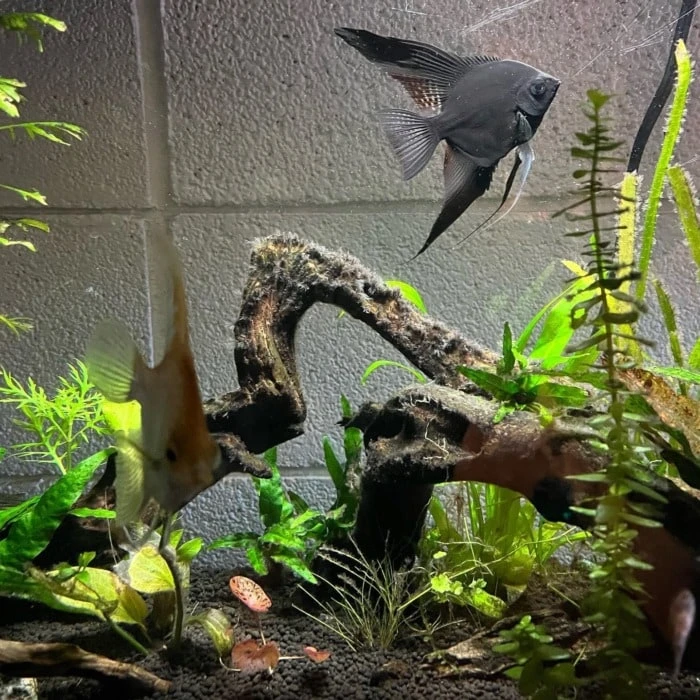
by Ivy_Bells
The truth is you will always get a few BBA spores no matter how careful you are when you pick up new plants or fish. But algal spores won’t be a problem if you don’t allow them to grow and develop.
The two main causes of black algae outbreaks in aquariums are:
- Imbalance of nutrients in the water. Note that I’m saying imbalance and not just “too much”.
Insufficient CO2 in your fish tank is one example.
In that case, your plants simply can’t compete with the algae, because of inefficient photosynthesis processes.
Too much leftover food can result in high phosphate levels which are also favorable to the algae’s growth.
- Improper lighting. Algae takes advantage of the excess light that hits your tank but is not used by your aquatic plants.
Rarely your aquarium’s plant will need over 8 hours of light per day.
However, more often than not, sunlight that’s hitting your tank from a nearby window is often the culprit here. Algae grow like crazy from white daylight but they also really like blue light.
So it’s not a good idea to leave that cool-looking “actinic light” on your aquarium’s LED during night time.
Here are some proper lighting options to consider for a planted tank, that also have customizable spectrums. The link leads to a guide where I give detailed advice on how to approach your aquarium lighting in the correct manner.
Anyway, with the right approach, permanent removal of this type of algae is possible. Algae-eating fish such as the rubber lip pleco, Siamese algae eater, the American flagfish, and the black molly can help immensely.
The issue, however, should be resolved at its core. You don’t really want to rely on algae eaters to manage algae issues.
Here’s what a heavy black beard algae infestation looks like in an aquarium:
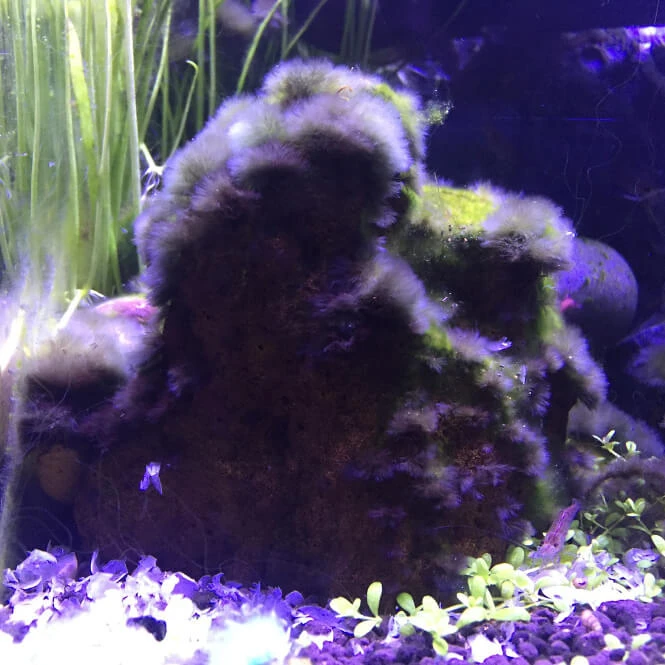
by Grahms
And here’s how black algae appears inside a pool:

How to remove black beard algae from your aquarium once and for all?
Despite being really good at exploiting nutrients, this invader has weaknesses. Even though it took me some time, I did my research and came up with a couple of solutions.
They have all been tested in my or other people’s fish tanks.
I am confident to share them with you.
To get rid of the black beard algae in your aquarium for good you should:
1. Dip all of the affected decor and plants in Hydrogen Peroxide.
A regular over-the-counter peroxide solution of 3% is strong enough to kill black algae.
Peroxide dips are often used for fungi treatment on new plant seeds right before their germination.
Bear in mind that the more gentle live plants in your aquarium like Japanese Moss balls and Anubias may take some damage as well.
For killing the algae on more sensitive plants, I recommend using a 1:3 solution of Hydrogen Peroxide to water. This way the solution will be weaker and spare your plants, but it could take more than one dip to completely rid them of the hair algae.
Anyway, it’s worth taking the risk considering you’ll be removing the nasty black beard algae that are suffocating the plant’s photosynthesis.
If you only have plastic plants you can even use bleach in a 1 to 20 ratio, although peroxide will work too.
Soak all other aquarium decor that is visibly covered in black spots or fuzzy patches for 2 to 3 minutes (use a timer!) and then rinse thoroughly.
The nice thing about peroxide is that it leaves virtually no residue and you can instantly put your plants and rock back in the aquarium. That’s because Hydrogen Peroxide quickly breaks down to oxygen and pure water when exposed to light.
Anyway, I know that soaking in pure peroxide might seem a little radical, but in my experience, this is the best way to remove black algae from any plants or other aquarium decor.
Another less effective but still viable method here would be to spot-dose the peroxide.
That’s done by using a syringe with the solution and squirting some of that right over the affected areas in the tank.
This is done directly in the tank, without removing decor.
However, simply dosing teaspoons of peroxide in your fish tank water won’t cut it for black algae.
Author’s note: Never soak your tank’s substrate. The substrate is where most of the beneficial bacterial colonies live. You want to keep these bacteria alive so that they can keep transforming toxic ammonia into nitrate, which is almost harmless to your pet fish.
2. Reduce phosphate (PO4) in the water.
Phosphates are a byproduct of almost everything that decays in your aquarium.
This includes leftover food when you accidentally overfeed, plant and algae decay, and even fish waste.
However, phosphates will also spike with the use of carbon filter media, hydrogen ion buffer solutions (pH buffers), kH buffer solutions, and aquarium salts.
If these sound like way too many possible causes, know that I haven’t even revealed the main one yet.
Tap water itself.
The local water authorities, however, found a clever way to fight the lead corrosion in the pipes.
Lead poisoning is quite dangerous so they figured that adding some phosphates to the water (which are basically harmless) will prevent said corrosion.
It’s a smart move to test your tap water for PO4, which can be the hidden reason behind your aquarium algae infestation. Unless there are a lot of other aquatic plants in your aquarium to use it up, Black algae thrive in phosphate levels of 1 ppm and above so your testing results need to be rather precise.
One of the more reliable Phosphate testing kits that I would recommend is the one from API, but you can research other brands as well if you have the time.
Anyhow, if you suspect that your tap water is the issue, then you have two options:
- Find another source of water for routine water changes – Distilled or purified water with reverse osmosis (this is a guide I wrote on which one to use) will surely starve your black algae.
If you revert to this solution know that this water needs to be remineralized before adding it to the aquarium.
That’s because water purification removes all minerals – the bad AND the good.
Remineralization adds back the good minerals and the water becomes usable for aquariums again.
Anyhow, a phosphate-free remineralizer I found, that does wonders is Seachem Equilibrium.
- Introducing phosphate absorbing media to your filter – If you end up getting a PO4 absorbing media, make sure that your filter turns the water in your fish tank at least 5 times per hour. A canister filter may be a good option here.
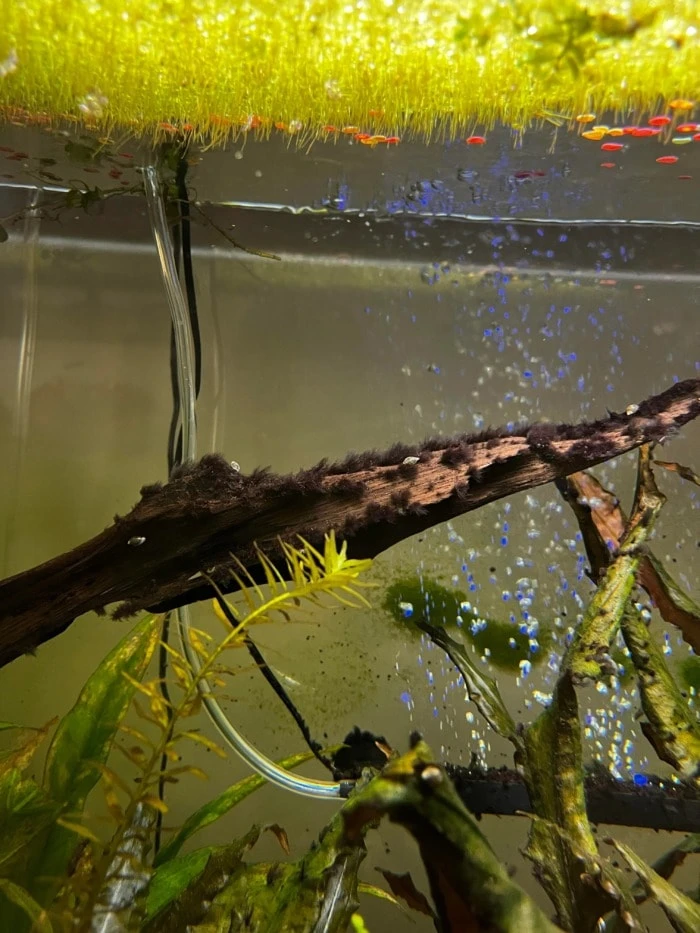
by coralkat
If your aquarium water tests read high PO4 and the tap water shows values below 0.25 ppm (which is considered safe) there are a few ways to lower it by eliminating the causes.
To lower phosphate levels in an aquarium you can:
- Add fast-growing floating aquarium plants – most freshwater floater plants have an enormous hunger for nutrients in the water column of your fish tank. They grow super fast and therefore need a lot of food, which includes Phosphates. I’ve got a quick list of 16 floating aquarium plants that you can check out.
- Replace current fish food – PO4 is used in the making of flake foods, but there are ones containing less phosphate. Elos is a brand that comes to mind as I know for sure that they make efforts in adding as little phosphate as possible.
- Feed your fish sparingly – uneaten food will eventually release phosphate and encourage black algae growth. Dosing meal portions is vital and you should take the number and type of fish you have into account.
- Clean the tank more often – As redundant as it may sound it’s a good idea to go one further on this one. Food and other debris are the usual suspects for phosphate build up in your water.
Always clean filter media with dechlorinated water not to kill any beneficial bacteria that live on it.
- Clean the filter – Filters are known to hold enough muck and residue that will eventually spike the levels of PO4.
- Opt for a carbon media with phosphate absorbers – This is for freshwater fishkeepers. Saltwater carbon filter media is often made in a way that prevents phosphate build-up by default.
- Review your water conditioners – These often have PO4 in them. Everything that treats water from buffers to pH alteration products contains a good amount.
Do yourself a favor and research them well, before buying.
3. Feed your plants by boosting Carbon Dioxide.
Whenever the CO2 levels in your aquarium become low your aquatic plants find it hard to extract the needed amount from the surrounding Hydrogen carbonate.
Black algae, however, is really good at that and it will out-compete your plants and thrive.
When this happens your pH will elevate, which is a really good sign that a poor CO2 level is your problem.
In an aquarium low on carbon dioxide, the algae will be stiffer to the touch and even the Siamese Algae Eaters won’t bother munching on it. By raising the CO2 levels in your aquarium you give your aquatic plants a kickstart to the competition for nutrients and the eventual starvation of the algae.
CO2 is a vital part of the process of photosynthesis and is one component that, when ramped up, actually speeds up the process.
With increased rates of photosynthesis, your aquatic plants will become competitive at sucking up nutrients in the water that would otherwise go to the black algae.
Soon after the effect takes place the BBA will become weak and therefore an attractive snack for your algae eaters, if you have any.
Two stones with one bird, so to speak.
Aside from a gas cylinder and a CO2 regulator with functioning solenoid, there’s another indirect way of allowing your plants to get more Carbon Dioxide in a fish tank. That’s a product called Seachem Flourish Excel.
The active ingredient can be toxic to fish upon continuous use.
It basically works by eliminating the built-up biofilm on plant stems and leaves, which allows them to draw CO2 from the water more efficiently.
If you have fish and invertebrates in the tank, go for half the recommended dose and treat it as a temporary solution.
Just in case.
Also, there’s another algae remover called “No More Black Beard”.
However, this algae remover has a similar active ingredient to Excel, so if you end up getting it, be careful with the dosage as well.
Anyway, back to CO2 injections the classic way, you should aim for 20 to 25 ppm of CO2, granted that your Oxygen levels are in the healthy range.
Don’t forget that carbon may spike your tank’s phosphate, but that’s not an issue when injecting CO2.
The benefits of algae control here significantly outweigh the disadvantages.
4. Introduce black beard algae eaters to your fish tank.
The true Siamese Algae Eaters (SAE for short) are known to feed on black algae.
There’s a catch, though.
Hard, unappetizing algae is a result of low carbon dioxide in planted tanks.
They use the limescale precipitate in a process that hardens their wall cells.
This method should be combined with either the peroxide soak or the CO2 injection method. Both methods will render the algae weak and soft enough for your SAEs to feast on it.
Many people I know report that after weakening the algae a sudden interest from their algae-eating tank pets occurs. That being said, true Siamese Algae Eaters (visit the link for more info on this fish) are not your only friends when it comes to an appetite for algae.

by rtchal
You’ll be surprised at how diverse the reports are on what else eats black beard algae in aquarium habitats.
Most plecos should eat the stuff by definition too, with the rubber lipped ones doing it at impressive rates (link to a complete guide I wrote on those). When the black algae are in their early stages like black spots or small hairy patches even fish with smaller mouths like the Otocinclus would eat them.
Here’s a full list of reported black hair algae eaters:
- American Flagfish – Jordanella floridae;
- Black Molly – Poecilia sphenops;
- True Siamese Algae Eater – Crossocheilus siamensis (young ones, as they pick the habit of feeding on the stuff);
- Chinese Algae Eater – Gyrinocheilus aymonieri (I don’t recommend getting this fish because it becomes too aggressive with age);
- Twig catfish – Sturisoma panamense;
- Bristlenose pleco – Ancistrus spp.;
- Rubber lipped pleco – Chaetostoma formosae;
- Pigmy suckermouth – Otocinclus spp.;
- Rosy Barb – Pethia conchonius;
- Cherry Barb – Puntius titteya;
- Common Goldfish – Carassius auratus;
- Panda Garra – Garra flavatra.
The Amano shrimps are also avid black algae eaters.
Side note: Let me know in the comments if you’ve seen other fish feasting on BBA, so I can expand this list further.
I have written an extensive guide on the best algae eaters in the aquarium-hobby where you can learn more about each of the species listed above.
5. Boil it away with heat treatment.
Algae like warm but not too warm.
Heating up the water is another very effective way of getting rid of the stuff, but you’d need to relocate the inhabitants of your fish tank first.
Find good temporary storage for your fish and live plants.
When I tried this, I left my driftwood and a couple of fake plants in my aquarium as they were all covered in black beard algae.
If it’s just your driftwood that is having algae on it – you can take the piece out of the tank and “boil” it separately.
The whole procedure took me only an hour and a half.
Put your heater at 110 °F to 120 °F (45 °C to 50 °C) and wait it out.
As you can see it’s not literal boiling but just bringing the water to a very high temperature.
I had algae on my live plants as well so after I removed them I dipped them in hydrogen peroxide.
The heat will burn the black algae causing it to eventually die off or get eaten by your algae eaters soon after.
My tips for extra efficiency:
- I would not recommend using water from the fish tank in the temporary one if you’re about to execute the heat method.
Some algae spores might still be present.
The good thing is that the removal will only last a little over an hour, so no cycling and all that is needed.
- While you wait for the water to heat up you can add a couple of spoons of peroxide.
I did a ratio of 1:150 peroxide to water.
Don’t worry, the peroxide dissolves and will not harm your fish afterward with that ratio.
The algae, however, will most likely be permanently destroyed.
- Clean the gravel before the heating.
Get rid of any leftover food or fish waste.
6. Cut out the photosynthesis of the BBA.
This one could be risky if your tank is heavily planted.
Black algae need light but so do your live plants.
This is also the method that was the least efficient for me, but I feel like it’s worth mentioning.
What I did was turn off the lights on my aquarium for 3 days straight.
I made sure no sunlight from the windows could reach the tank too.
After that, I adjusted the daily exposure to light to about 6 hours (instead of the regular 8).
It took the algae more than a week but it did start to disappear.
However, this was not a permanent solution to my problem.
In the rare case where overfeeding your planted aquarium with light is the cause of your BBA issue, it will work for you.
Bear in mind the light needs of your plants – if they are low to medium-light plants then it would probably not damage them.
Prevention of outbreaks – How to never get black algae again

If you got to this part of the article you probably have the answers to that already.
But it’s important to follow this checklist once you’ve defeated the unwelcome invader.
Black beard algae WILL take advantage of any favorable conditions.
To prevent BBA from ever coming back to your aquarium I strongly recommend that you pay attention to:
- Overfeeding – everyone can get carried away with that. I have.
After all, we do care about our pets and want them to feel good, the main part of which is being well-fed.
However, excessive food is also food for algae. Do research on the fish you have and feed them accordingly.
If you’re not confident that you will never overfeed again, I can recommend getting an automatic feeder. Eheim offers one, that’s actually pretty reliable.
If you want to see how the device looks, Amazon has it. There’s also the advantage of not having to worry about feeding when you’re out of town.
- High PO4 levels – You don’t want anything above 0.25 ppm of free Phosphate in your aquarium. If Phosphate is being introduced to your tank in some way you can’t control, there should be enough live plants inside to use it up, instead of the algae.
- Aquarium hygiene – You are probably eye-rolling, as I know everyone is religious when it comes to cleaning. Still, all waste products, even in your filter can cause nutrient imbalance.
- Excessive light – Keep the lights on as much as needed but no more. Investigate your plants’ needs.
- Low CO2 levels – Carbon dioxide is vital for your live plants. With the right levels, they will be able to function properly and effectively use all other nutrients they need.
Healthy plants will outcompete any algae.
- The right equipment – Once you get rid of the intruder you can count on gear to prevent future outbreaks.
Killing algal spores before the bloom occurs is your best bet. Ultraviolet sterilizers use high-energy radiation that damages the DNA of the spores, preventing them from explosively multiplying (visit the link to learn more about that). - Live plants from unknown sources – You could get a plant that carries black algae (though not visibly) even at a big pet store. It’s not paranoid to run them through a light disinfection procedure before adding them to your fish tank.
Use Hydrogen peroxide and water in a 1:4 ratio and let the new plants soak for a couple of minutes.
Better safe than sorry.
- Questionable pet store water – Whenever you buy a new fish, use a net and don’t just pour the water from the bag in your aquarium.
It would be even better if you quarantine the fish for a while before adding them to the tank.I usually wait for 24 hours.
My Conclusion
Black algae is a menace and also one of the most stubborn algae out there.
However, this does not mean we should tolerate it.
And if you take precautionary measures, you’ll never have to deal with it again.
And now I have a question for you.
Did my advice help you?

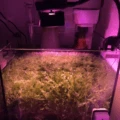
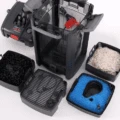

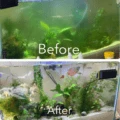
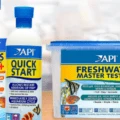

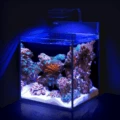

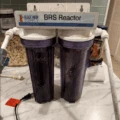
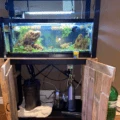
This has been the most informative article about BBA I have found. The Internet has so many conflicting pieces of advice but you put it all into the proper perspective. To permanently rid BBA it must be attacked from numerous facets. I’m very encouraged and hopeful I will at last be rid of my tank’s nemesis! Thank you so much!
Hi Jennifer,
I’m super glad that my article gave you hope for fighting the intruder. I know how discouraging it could be when your fish tank is covered in black algae, but this in itself makes the victory 10 times as sweet!
In your experience will intense UV light (such as used for curing UV resin) kill BBA, or will it only kill the spores, if that?
Also regarding spot treating via a syringe and Hydrogen Peroxide (3%), how do you approach this? Just a slow “injection” of a second or so directly over the BBA? My BBA is pretty well distributed in small clusters on driftwood mostly and will require multiple such points of treatment which concerns me about the quantity I add to my aquarium (33 gallons actual gallons in a 50 gallon aquarium taking into consideration displacement.)
My Crossocheilus siamensis, bought purposely to keep BBA in check, could care less about it.
My best solution has been removal of driftwood and exposing to “instant hot water” (190°F) which is challenging with plants that are attached to the wood, but done carefully it has temporarily worked.
My tank is well infused with CO2 and cleaned weekly with 12 gallons water replacement along with as careful as possible bottom cleaning in a heavily planted aquarium.
Hi Wayne,
I have no experience in killing Black Beard Algae with UV light, as I haven’t tried that yet. If the beam is energetic enough, it should kill it, in my opinion. What I could tell you is that I did a quick search on Amazon about UV lamps for curing resin and most of them produce light with a wavelength of 350 nanometers or longer. “Germicidal” UV light (the one that kills microorganisms) is within the 280 to 240 nm wavelength range. Following these thoughts, I don’t think such a UV lamp could kill BBA.
Anyhow, I approach spot treating, exactly as you described. If the black beard algae are well distributed, I’d dose Hydrogen Peroxide in the whole tank (please find my comment response to Lauren to see an explanation of how I’d do that).
About the multiple treatments – it depends. It could be that the first couple of treatments make the Beard Algae soft enough for the Siamese Algae Eater to eat it. I’ve seen that happen.
If your problem persists after you did a local boiling treatment, then I’d assume it’s something in your water that’s preventing your aquarium plants to compete with the algae for nutrients.
You could:
1. Reduce the about of blue light in your LED light’s settings to about 10-12%.
2. Do a whole tank Hydrogen Peroxide treatment for a week, followed by a HALF-the-recommended dose of Seachem Excel. This method will definitely kill the algae and it may actually boost your plant’s growth because Excel will destroy the built-up film on your plant’s stems and leaves that blocks the adequate nutrient absorption.
3. You may have elevated PO4 levels. Phosphorus is needed for plant growth but higher levels of it in the aquarium will also encourage beard algae to appear.
Hope this helps,
Good luck with the treatment and don’t hesitate to keep me posted or ask questions. 🙂
I have spot treated with Hydrogen Peroxide and will observe to see how that works. May I assume that I should see some results in a day or two? If not killed outright perhaps the Siamensis will finally do his job! (Three Otocinclus and a Clown Pleco also show no interest.) I plan to take one step at a time rather than a “buckshot” approach.
You are absolutely correct that UV resins cure at approximately 350 nanometers depending on the resin. As of this morning I saw no changes in what I had treated with a very fine point high intensity lamp, so unless UV light takes a while to kill, lamps of higher nanometer value likely will not work.
Hinging on how spot treating goes I may try Seachem Excel next. I believe with my LED lamp I should also be able to adjust the blue light, so that might follow if the other efforts fail.
Isn’t there some sort of a combination activated carbon and a resin product that helps remove phosphates? Perhaps I am thinking of Seachem PhosGuard? Will the addition of PhosGuard with activated carbon be a worthwhile consideration? Currently I filter with bio balls (aerobic and anaerobic), sponges, 1/2 cup activated carbon, and Poly Filter. The latter two are replaced every 4 weeks.
Thank you for your advice – very much appreciated.
Hi again,
PhosGuard is a good option for decreasing excessive Phosphates, yes. I use it or similar product as a sort of precaution measure on every tank that’s been previously consumed by beard algae. Consequently, the algae never come back.
Another product by Seachem called SeaGel is a combo of activated carbon and phosphate-absorbing media. Read the instructions carefully on that one and use it accordingly. SeaGel seems like a good option for your particular setup since you’re already using activated carbon.
All in all, I think between the Hydrogen Peroxide, the Excel, and the SeaGel/PhosGuard you’ll definitely eliminate the black algae. You’ll just attack too many fronts, ha.
Hope this helps!
My approach for 14 days had been conservative using a 1ml syringe “spot treating” to specific areas. I have learned it takes more than 0.25ml to see any affect so have chosen to inject pretty thoroughly to get best results. I know I will have best success when the Algae turns reddish in color. If over time my “spot treatment” is not successful, thanks to your suggestion I have alternatives you have suggested above.
I am experimenting to see what Hydrogen Peroxide (3%) will do to Green Spot Algae when applied in the same way. I also have carefuly applied it to some Hair Algae in my wife’s 5 gallon aquarium with shrimp. What sort of results should I expect? And now that I have done the deed, how safe is it with shrimp?
Hi again,
Hydrogen Peroxide will kill most all algae. Its effects in the shrimp tank depend on how much organics there are in the water. Hydrogen Peroxide oxidizes the organics. If the shrimp tank receives fertilizers then it likely has a high level of organics and dosing H2O2 will be pretty much safe at no more than 2 ml/gallon, in my experience.
It does have the potential to harm but, only if the tank is maintained pristine and there’s nothing left to oxidize besides live animals…
This is rarely the case in our home aquariums plagued by algae. Algae is usually a sign of excessive organics in the water.
All in all, I’d say start with at least 0.5 ml/gallon when spot treating in the shrimp tank and monitor the shrimp.
Just to make things clear – you’ve been spot treating the algae in your other tank for 14 days with no effect? If so – try upping the dose. You are correct – the treatment has been successful when the algae turn red-orange or even white! In my experience, you can go to up to 3 ml/gallon for aquariums that were not treated with Hydrogen Peroxide recently (and have high levels of organics in the water).
Good luck again!
The effect with spot treatment has been mixed. I believe that I was not initially injecting as much H2O2 as needed. My approach after reading your note yesterday has become more aggressive with the amount I inject over specific spots of algae. I see this morning that many have turned pinkish-red while a few have not changed color. I will consider retreating those perhaps tomorrow. Most of my issues are on drift wood with a few scattered within a clump of Taxiphyllum ‘Flame Moss’ and on the edges of the inflow jets. (I turn off the pump when I spot treat to help concentrate the H2O2 where I want it.)
The greenspot algae on some Hygrophila pinnatifida leaves shows no change thus far. I did not know if I should expect a color change or not with greenspot.
My wife’s shrimp appear to be fine today. I spot treated her 5 gallon with approximately 4ml of H2O2, so unless they were extremely sensitive I did not anticipate any issues. No question she has organics present with both string algae (that keep the shrimp happy) and a couple of small locations of Black Algae.
Since you suggest to Lauren 2-3ml/gallon/day would I assume correctly that H2O2 dissipates out quickly – perhaps within hours?
Thanks so very much for being there for so many of us dealing with this.
Hi, again Wayne!
You are on the right path with the treatment. That’s great news!
Also, you are correct, H2O2 does degrade fairly quickly. Again, depending on the organics in the water, but usually within 1 to 3 hours in the aquarium environment.
Hello,
so I have a 30 gallon tall tank, a 42 gallon bowfront, and a ten, all with live plants. Ten gallon is clear of BBA for now. 42 has some on the mopani wood, and 30 gallon is OVERRUN. Tanks are fully cycled, set them up one after the other over a year ago—when the BBA first appeared on the wood, I thought it was a cool natural looking growth….silly me. So I am planning a full on take down of my 30—I want to move all the fish out and keep them temporarily between the two other tanks. Hate the thought of it- but feel it’s the only way. I’m looking for more specific advice on the hydrogen peroxide mixture for wood, plants and decor. It’s also all over the filter tube and the outside of my UV sterilizer (with by the way, I finally got a new bulb for, so hoping that will help). Any other advice would be greatly appreciated. I plan to crank up the heat one I move everyone out.
Thank you,
Lauren
Hi Lauren,
You could actually dose Hydrogen Peroxide directly to the tank with the fish still inside. It’s safe as long as you’re careful with the dosage and it’s the 3% one. For an overrun tank I would recommend dosing 2 to 3 ml per gallon, once a day. Don’t turn off the filter or lights when dosing, it would not make much of a difference. I would start with 2 ml/gallon and see if any of your fish shows distress, which, in my experience, is highly unlikely. If everyone is fine you could up the dose to 3 ml /gallon, but that should not be necessary as 2 ml will be very effective. This will save you tons of time and headaches. 🙂
You could treat your other non-overrun tank with spot-dosing. This means just using a syringe to target-drop the Hydrogen Peroxide (3%) directly over the algae.
Do NOT crank the heat up while dosing Hydrogen Peroxide.
I hope this helps. Keep me posted.
Momchil
Hi I got a old swimming pool it add black mold on I’ve cleaned it will it harm anany of my fish I only got carp and tench in going in
Hi,
No, it will not harm the fish.
Good luck!
Yes, this did help. Thank you.
Thank you for your feedback, Kristin!
Hello Momchil
First of all I would like to express my gratitude for sharing this vast amount of extremely useful information.
I think I am being involved with the BBA issue. I noticed small very dark green to black patches on my gravel and plants, following a major cleansing of the tank. I am new in fish keeping and after buying a second hand tank which had only gravel not sand and no signs of BBA, I decided to add sand under the gravel. The sand was packed, authentic and brand new. But I washed up all the things inside the tank. Every thing looked clean and shiny, but after almost a week I saw this black patches. They are not like beard or hair (maybe because its the beginning). I am not sure if it is BBA or something else. Where do you think they have come from? Is it because I washed out the good bacteria or not? Note that I think we have problems with very hard water. Can I send you a photo of it to be diagnosed?
Please help me with this issue.
The aquarium is 60l tropical fresh water.
Hi Soorena,
That definitely sounds like the initial stages of black algae (no need for photos IMO)! Did you test your water for PO4?
No I’m afraid not. I think it might have high PO4. But could they have come with sand? As I forgot to boil the sand before adding it.
I don’t think so. The most common source of PO4 is tap water and organic waste in the aquarium.
Thank you so much for your reply. Can I use bleach instead of H2O2? for sand and gravel? And do the gravel need to be rubbed or brushed in addition to be put in H2O2 or bleach?
Hi again,
I would not recommend using bleach in anything aquarium. You could mix a veeery diluted solution, but I’m not currently aware of the bleach to water ratio that would be safe. You can’t find Hydrogen Peroxide? It works great without posing harm to the fish tank as long as you follow my directions. For the very sensitive aquarium plants – dilute it at 1:3 peroxide to water. Anything else can go in pure peroxide for a limited time.
You do not need to rub or brush it, the oxidation of the H2O2 will do its job just fine.
I hope this helps!
Yeah. It definitely helps. Thanks. In my previous question I meant, could BBA would have come with sand?
Oh, yes, definitely.
I’d argue that there are spores of it in almost any fish tank, however, if nutrients are kept under control, the BBA wowuld never overtake the aquarium. 🙂
Good luck Soorena!
Thank you Momchil, you are great!
Thank you as well!
We’ve been fighting Black Beard Algae in our tank for several years. In that time we’ve changed the substrate, removed and replaced live plants, switched to LED lighting and limiting the time to 8-9 hours on, changed water every 2 weeks, nothing worked … It’s been a battle that we nearly lost. Last fall we went on vacation for 2 weeks. The tank was cleaned the day before we left, the lights on a timer, our friend feeding the fish every day. Our tank was literally full of algae when we got home. Two months of cleaning and treating did nothing but grow more algae. Our tank walls were green and we didn’t know what to do. I stumbled upon your web site and read all your suggestions. First we moved the fish out of the tank. Next, we started with removing the top layer of gravel on the bottom. We soaked the large rocks in peroxide, scrubbed the algae off, soaked again and rinsed well. The plants were removed and soaked in peroxide for three minutes, rinsed, and trimmed back to the roots. We scrubbed down the tank, added new gravel substrate, planted the roots of our plants, added the large rocks, put the fish back in without any of the old tank water (that was scary), added the phosphate remover you linked to, and finally Seachem Flourish Excel. We clean our tank every 2-3 weeks, replace the phosphate filter every cleaning, make sure not to overfeed, and add Flourish Excel daily. 3 months later, our tank is still clean and beautiful, no one trace of algae. The plants are coming back at a rapid rate. After years of fighting this horrible algae, we are cautiously optimistic that we’ve won. We literally followed all your instructions. We were at a point where I was ready to give up on our tank. Thank you so much for all the advice!
Hi Terra,
I’m extremely happy everything worked out for you guys.
I know many people that were super discouraged from persistent black algae problems, but in the end it’s important to keep doing your research and eventually you’ll come out as a winner.
I’m very happy for you! Make sure to spread the word 🙂
Good job. I will add if you think of Chinese algea eater. BEWARE. They are mean. Mines 6 inches and total jerk. He cleaned up my algea but now i want to stab him with fork. Also flourish is amazing. Great article. Thanks
Momchil,
I found this information very helpful and somewhat comforting. I couldn’t figure out what this black hair-like stuff was growing in my tank and it looked incredibly like the hair my black lab sheds (and he sheds like crazy). I just did a major clean and water change in my 60 gallon tank. I was going to get rid of my decor but now I know how to treat it. Thank you very much. I did notice that my Yo Yo Loaches love this stuff (they are almost like a cat with catnip) which is one reason that I didn’t worry too much that it was harmful, but it takes over quickly. Besides water changes with tap water the only thing new that I introduced to the tank were the Yo Yo Loaches,(They brought their own snack apparently. lol) I do over feed though so I guess I will cut back and let the automatic feeders take care of it. I rarely add CO2, so I will start doing that regularly. The only thing I don’t want to do is cut back my lighting. I have fantastic lights that I bought from Dustin”s Fish Tanks! They are amazing and I leave them on 12 hours. I guess I will cut back though if I must. They are on a timer so that shouldn’t be an issue. I like Black Mollies and this is a community tank so I think I might add a few and I love SAEs so maybe I will get a few of those as well if I still continue to have BBA issues I love watching my fish! Again, I can not thank you enough for your information! Happy fishing!!!!
Hi Yvonne, and thanks so much for sharing your story.
It’s nice to see someone talking about their aquarium with such passion.
About your lighting – you can just reduce the daily photoperiod to, say, 8-9 hours. No need to change/remove the fixtures themselves.
Thanks again for sharing your story and happy fishkeeping!
Momchil
Very good article.. I’m presently dealing with an outbreak of BBA.. CO2 and ferts. All my plants are slow growing epiphytes, Anubias, Java ferns bolbitis and bucephalandra.. I’ll try to employ your methods here and see how it works.
Thanks
Yes it certainly did thank you.